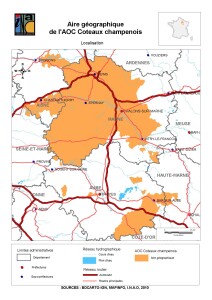The mere mention of the word “Champagne” brings visions of beautiful, bubbly wine…and rightfully it should, as the Champagne District is home to what is arguably the world’s most famous sparkling wine. The aligned appellation—the Champagne AOC—strictly defines the wines of Champagne and is valid only for use on certain French-produced, closely protected, and highly regulated sparkling wines.
However, winemakers within the Champagne Region—located about 100 miles/160 km east of Paris and covering portions of the Aube, Marne, Haute-Marne, and Ardennes departments—may also produce still (non-sparkling) wines under the Coteaux Champenois AOC.
The Coteaux Champenois AOC was originally established in 1974 and allows for white (blanc), rosé, and red (rouge) wines to be produced using the same grapes that are allowed in the sparkling wines of the Champagne AOC. Since 1974, the list of allowed grape varieties has read as follows: Chardonnay, Pinot Noir, Meunier (Pinot Meunier), Arbane, Petit Meslier, Pinot Blanc, and Pinot Gris; however, in practice most of the region’s Chardonnay and Pinot Noir is used in the area’s sparkling wines.
Well-versed students of wine might recall that just a few months ago (December 2023, to be exact), the list of grape varieties approved for use in the Champagne AOC was expanded by one (very unique) white grape—Voltis. Voltis is a hybrid variety chosen in part due to “interests for the purpose of adaptation” (intérêt à fin d’adaptation) and to respond to the challenges of climate change.
As such, it should come as no surprise that the regulations concerning the grapes allowed in the non-sparkling wines of the Champagne region have also been updated. As of July 18, 2023, the Coteaux Champenois AOC allows for use limited of the Voltis grape variety. Mimicking the recent revisions to the Champagne AOC, Voltis will be limited to 5% of the vineyard area of any estate and no more than 10% of the final blend of any cuvée.
We’ll be watching to see what vineyards and estates begin using Voltis in the wines of the Coteaux Champenois AOC. It should be interesting!
References/for more information:
- Cahier de Charges – Coteaux Champenois AOC updated 2023
- Official Journal of the EU-July 18 2023
- Map of the AOC Coteaux Chapenois via the INAO
Post authored by Jane A. Nickles…your blog administrator: jnickles@societyofwineeducators.org

